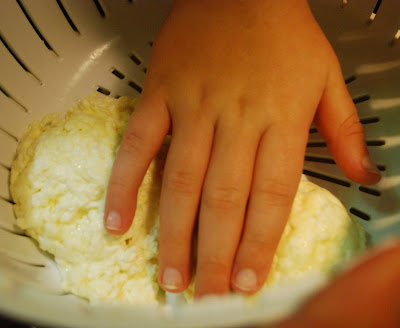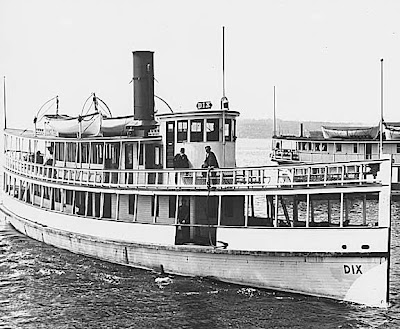TREKKING: We scored a bike rack off Craigslist for $40 which fits nicely on our Honda's spare tire, so we gave the new rack a go and took the bikes down to the path that runs along the eastern edge of Puget Sound nearest to the west slope of Queen Anne hill.
It was a bit chillier than we were dressed for, but the scenery sure made up for it.
Along the way we encountered a waterfront exercise course. CJ gave the parallel bars a whirl.
While Annabelle enjoyed an excellent view while doing some sit ups.
We also stopped so the kids could climb on a large art installation. Here, CJ tried to carry the old Seattle PI ball.
And today, next to a huge grain elevator, we saw our first cherry blossoms!
CONEHEADS: Poor little pups. Kirby and Laika both went under the knife today. We took them to the vet before 9 this morning for their appointments to be spayed. When we picked them up 7.5 hours later, they were both drugged out of their heads and wearing big ol' cones, poor things.
When we brought them home, we put them on the floor on blankets. Within seconds Annabelle cooed, "Oooh, look, how cuuute! They're touching cones."
ROAD TRIP: Saturday, we made about a 350-mile round trip to Vancouver and back. Our primary reason for heading south was to visit a dear family member who was just out of the hospital. It was very good to see her, and definitely worth the drive!
While down south, we took a few minutes to visit the park that used to be in our backyard. It's the first and foremost playground CJ and Annabelle frequented for the earliest years of their lives. As we watched them clamber on, over and under the equipment with ease, it was hard to remember the days when they could barely even walk around it.
SUNDAY MATINEE: We headed up to the good ol'
Crest theater in Shoreline where you can see a 3D movie for just $4.50 (instead of $14!), and have the best popcorn in town (they use REAL butter). We went to see "Wreck It Ralph," which we had seen last fall in a sneak preview. We all loved it and were waiting for it to come to the Crest so we could go see it again. This time Rick went with us. It was a full house and there was lots of laughter and applause from the audience.
Sunday night, we started playing a new-to-us game called "
Primordial Soup." It's a board game where each player is in charge of a team of amoeba. On each turn you're given biological points and your amoeba move, eat and procreate. Ultimately, you're trying to accumulate enough biological points to evolve.
It's a bit complicated, but we managed to work our way through an hour or so of it. We probably have another hour or so to go to complete it.
THREE FIFTHS: We took our second Week 3 astrobiology quizzes on Sunday. The subject matter was mostly about Europa, Enceladus, and other icy bodies in our solar system which might harbor life.
Europa, one of the four moons of Jupiter discovered by Galileo, is a candidate for life because scientists believe that below its icy, crusty surface, there is an ocean of liquid water with salinity. Scientists wonder if Europa's oceans have vents in them, like our oceans, and what the chemistry of those oceans is.
This false color image of Eurpoa was taken by NASA's Galileo spacecraft Sept. 1996-Feb 1997 at a distance of 417,489 miles. Per NASA, "The reddish-brown areas represent non-ice material resulting from geologic activity. White areas are rays of material ejected during the formation of the Pwyll impact crater. Icy plains are shown in blue tones to distinguish possibly coarse-grained ice (dark blue) from fine-grained ice (light blue). Long, dark lines are ridges and fractures in the crust, some of which are more than 1,850 miles long." Photo courtesy - NASA/JPL/University of Arizona
Enceladus, a moon a Saturn, near its E-ring, was discovered by Hershel in 1789. Its surface appears young and reflective. When NASA's Cassini probe flew by in 2004, it captured high resolution images of plumes ejecting from the moon's south polar region. From Cassini, we know that the plumes contain water, ice, salt, methane, carbon dioxide, acetylene, propane and complex organic compounds (too complex for Cassini to sort out).
This photo, captured on Nov. 27, 2005, shows discrete plumes of a variety of apparent sizes above the edge of the backlit moon Enceladus. This image was acquired on Nov. 27, 2005.
NASA/JPL/Space Science Institute
We also learned about other icy bodies, such as Neptune's moon Triton; Jupiter's Ganymeade, which is also believed to have salty water ocean beneath its icy crust; Pluto's largest satellite, Cheron; and Titan, the largest moon of Saturn. It has rivers of liquid methane. Titan is intriguing because perhaps it is an example of an environment where life is using a solvent other than water.
Image of Titan captured by Cassini spacecraft on May 6, 2012






































